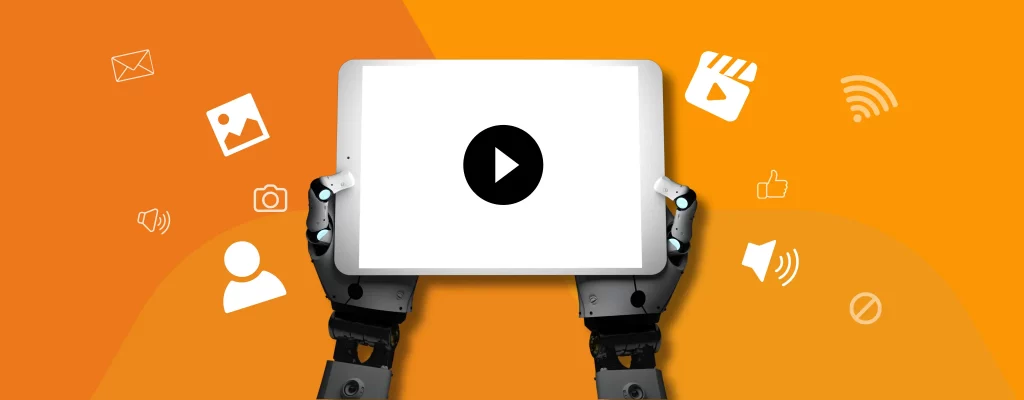The digital era paved the way for an unprecedented surge of video-sharing online platforms. Videos have become one of the preferred mediums for communication, entertainment, and information. This exponential rise of video-sharing has revolutionized how people connect, consume content, and express themselves online.
Anyone with a smartphone and internet connection can produce and share videos. However, the vast digital freedom sometimes warrants criminal minds to prevail. For instance, some users may post inappropriate videos to deliberately harm others or violate community guidelines.
But then, this is where AI video moderation steps in.
Understanding AI Video Moderation

The internet is a melting pot of videos and other media. While most of them are entertaining and informative, a few can be offensive and harmful. As such, it’s important for online platforms to employ a video moderator.
What is a video moderator?
It refers to an individual or a team responsible for monitoring and assessing online video content. They sift through online platforms to review videos and ensure compliance with community guidelines, terms of service, and legal requirements.
Traditionally, video content moderators are human. However, they often lag behind the rapid pace of content creation, which birthed exponential growth of user-generated content (UGC). Thus, integrating artificial intelligence (AI) has become a thing.
AI-powered video content moderation harnesses the power of AI tools, such as machine learning and natural language processing, to meticulously screen and evaluate online videos. It uses advanced algorithms to identify potentially harmful content, including violence, nudity, and graphic imagery.
By removing unwanted or harmful videos, AI video moderation helps enhance user experience and promote a safer online environment. Additionally, this advanced technology is more scalable and efficient than conventional video moderation.
Here are the key components of AI systems to moderate a video:
Computer Vision
Computer vision extracts and analyzes visual elements like frames and objects within videos. For instance, the algorithm may identify nudity, violence, or graphic imagery based on visual cues like skin tone, motion patterns, and object recognition. Extracting features from frames and objects helps AI video moderation identify potentially harmful content in real-time.
Machine Learning
Machine learning algorithms identify potentially harmful videos by undergoing intensive data training. They “learn” from labeled datasets to recognize patterns of appropriate and inappropriate video content. Once trained, AI video moderation systems can screen videos at scale, resulting in an efficient and scalable moderation solution.
Natural Language Processing
Natural language processing (NLP) technology processes and interprets textual elements within videos, such as spoken dialogue, captions, comments, and descriptions. By analyzing language semantics and sentiments, NLP allows AI systems to detect hate speech and abusive language within online videos.
Classification Algorithms
Classification algorithms label video content into different categories based on predefined criteria. For example, the algorithm may classify a video as safe, borderline, or unsafe, depending on the severity of its content violations. This process ensures high accuracy of video moderation solutions.
The Evolution of Content Safety Challenges

Presently, online platforms continue to grapple with safety issues. These challenges lie in the interconnection of technological advancements, societal norms, and regulatory frameworks, which all have significantly transformed over time.
Let’s look back at the digital challenges hindering user and content safety:
Early Internet Era
The early stages of the Internet were too loose in regulating content. There was minimal oversight and only a few content moderation mechanisms, meaning users have limited means to report inappropriate and harmful content. In short, the challenge in upholding online safety was due to the lack of tools and resources to monitor online content.
Rise of UGCs
The increasing popularity of social media platforms and online communities has democratized content creation, allowing users to share their voices online. This ushered in an era of vibrant freedom of expression.
However, it also brought forth new challenges in content safety. Online platforms grappled with moderating the vast volumes of UGCs, necessitating automated tools to keep online communities free from hate speech, cyberbullying, and misinformation.
Increasing Complexity
Besides the unparalleled volumes of UGC, online platforms faced the daunting task of moderating diverse content formats. Since then, UGCs have come in text, images, and videos, varying in language, form, nuances, and context.
The surge in content creation outpaced the capacity of manual moderation efforts. Hence, developing automated moderation solutions becomes necessary for online platforms.
Regulatory Scrutiny and Legal Compliance
The proliferation of harmful content online has called for increased regulatory scrutiny and greater accountability from content platforms.
For instance, the live stream of the Christchurch mosque shooting in March 2019 sparked widespread outrage and calls for action. People urged governments, regulators, and tech companies to address the spread of harmful content on online platforms. In response, policymakers worldwide introduced legislative measures to hold platforms accountable for content moderation.
The United Kingdom enacted the Online Safety Act in December 2020 to regulate online platforms and hold them accountable for protecting users from harmful content. Similarly, the United States introduced the Stop Enabling Sex Traffickers Act (SESTA) and the Allow States and Victims to Fight Online Sex Trafficking Act (FOSTA) in 2018.
Balancing Free Speech and Safety
The emergence of AI has opened the floodgates for automated content moderation solutions. These solutions use advanced algorithms to flag and remove harmful content, ensuring platform and content safety. However, its capacity to moderate content at scale has birthed ethical complexities.
Platforms must strike a delicate balance between fostering freedom of expression and protecting users from harmful content. But how can they do it?
Platforms must establish clear and transparent community guidelines to help users differentiate acceptable and unacceptable behavior. Furthermore, they must implement report mechanisms to encourage users to participate in the community’s effort to maintain online safety.
How AI is Transforming Content Moderation?

AI technology has fundamentally reshaped content moderation processes. From enhanced efficiency to scalability, it has offered myriad benefits in digital platforms.
Here's how AI technologies have revolutionized content moderation:
Automation
By employing computer vision, machine learning, and NLP, AI algorithms can automatically flag potentially harmful elements within online videos. This results in real-time and round-the-clock monitoring of UGC, curbing the spread of inappropriate videos as they occur.
Customizable Moderation Rules
AI video moderation tools offer flexibility in defining and customizing moderation practices. Online platforms can set the criteria for inappropriate content based on their requirements and community standards. For instance, they can set the parameters for what visual elements are acceptable and not.
Cost-Efficiency
AI moderation solutions can handle large volumes of content with minimal human input. Thus, online platforms can scale their moderation operations without the overhead costs of hiring and training additional human moderators. Furthermore, automating repetitive tasks like content moderation allows platforms to allocate resources more effectively and reduce moderation backlogs.
Accuracy and Consistency
AI algorithms can achieve high levels of moderation accuracy by analyzing content across multiple dimensions. It can curate videos of any length and form accurately and consistently, improving online safety and platform integrity.
Addressing Ethical and Privacy Concerns

Online platforms must consider potential ethical and privacy concerns related to using AI technology for video content moderation. Training the AI with less diverse and unrepresentative datasets may lead to algorithmic biases. Hence, online platforms must conduct regular audits of datasets to ensure cultural variation and racial representation.
Furthermore, AI moderation also raises concerns about user privacy and data protection. Online platforms should prioritize user privacy and data protection by implementing protective measures such as user anonymization and data encryption. Users should also give their explicit consent for data processing.
Addressing ethical and privacy concerns requires online platforms to consider the following practices:
Show Transparency
Particularly in video-sharing platforms, they must be transparent about their content moderation practices. They should inform users of the algorithms, data sources, and moderation criteria that they implement.
Providing users with clear information about the moderation process can foster trust and accountability. Additionally, users should know the corresponding sanctions for violating the community guidelines and standards, encouraging them to upload only acceptable and high-quality video content.
Obtain User Consent
Whether in the online or offline world, user consent is a must. Thus, digital platforms must obtain well-informed user consent for their content moderation activities. They should allow users to opt out or adjust moderation settings, particularly when user data are involved.
Content moderation goes beyond simply removing inappropriate content. It also involves respecting users' autonomy and privacy preferences.
Ongoing Evaluation and Improvement
Online platforms must continuously evaluate and improve their moderation processes. They should regularly check their AI moderation algorithms to ensure effectiveness, fairness, and compliance with ethical standards.
Regular audits, testing, and feedback mechanisms enable platforms to identify and address issues such as biases, inaccuracies, and unintended consequences of using AI for moderation practices.
Comply with Regulatory Frameworks
Regulatory frameworks are crucial in ensuring responsible AI use in content moderation. These frameworks provide guidelines and standards for AI development and deployment. They address the ethical, legal, and societal considerations for proper AI usage.
In short, platforms must comply with these regulatory bodies and industry associations as they enforce ethical guidelines and standards emphasizing fairness, transparency, and accountability in the content moderation
Enhancing Content Safety with AI Moderation

AI video moderation has revolutionized the way platforms and users collectively uphold content safety. Using advanced algorithms, AI has enabled platforms to analyze vast volumes of online videos at scale and in real-time. It allows platforms to detect and take down potentially harmful videos promptly and efficiently. In a nutshell, using AI for video content moderation significantly enhances user safety and platform integrity.
However, AI-powered video moderation is not without any red flags. It needs to navigate the complex digital realm and find the balance between using AI for effectiveness and addressing its ethical and privacy concerns.
And while this all sounds a little too complicated, Chekkee is just around the corner to help.
Chekkee offers video moderation services that provide effective protection against unwanted, inappropriate, and explicit visual content. It harnesses AI’s maximum potential without compromising ethical and privacy concerns because it employs dedicated human moderators to supervise AI systems closely.
Video-sharing is one way to boost user engagement on your platforms. However, leaving them unmoderated can do more harm than good. Contact us now to learn more!



